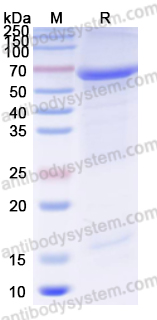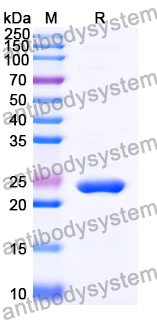Catalog No.
YVV35801
Expression system
E. coli
Species
Feline calicivirus (FCV)
Protein length
Ser129-Leu668
Predicted molecular weight
61.39 kDa
Nature
Recombinant
Endotoxin level
Please contact with the lab for this information.
Purity
>90% as determined by SDS-PAGE.
Accession
A0A286QWK5
Applications
ELISA, Immunogen, SDS-PAGE, WB, Bioactivity testing in progress
Form
Lyophilized
Storage buffer
Lyophilized from a solution in PBS pH 7.4, 0.02% NLS, 1mM EDTA, 4% Trehalose, 1% Mannitol.
Reconstitution
Reconstitute in sterile water for a stock solution.
Shipping
In general, proteins are provided as lyophilized powder/frozen liquid. They are shipped out with dry ice/blue ice unless customers require otherwise.
Stability and Storage
Use a manual defrost freezer and avoid repeated freeze thaw cycles. Store at 2 to 8°C for frequent use. Store at -20 to -80°C for twelve months from the date of receipt.
Alternative Names
Capsid protein, Coat protein
Isolation, Identification, and Genetic Evolution Analysis of VP1 Gene of Feline Calicivirus Strain ZZ202306., PMID:40141207
Epidemiology and Molecular Characterization of Feline Calicivirus in Beijing, China., PMID:40002976
The recombinant feline herpesvirus 1 expressing feline Calicivirus VP1 protein is safe and effective in cats., PMID:39467408
The Feline calicivirus capsid protein VP1 is a client of the molecular chaperone Hsp90., PMID:39373166
Molecular epidemiology and strain diversity of circulating feline Calicivirus in Thai cats., PMID:38887538
The CDE region of feline Calicivirus VP1 protein is a potential candidate subunit vaccine., PMID:38443948
Broad-Spectrum, Potent, and Durable Ceria Nanoparticles Inactivate RNA Virus Infectivity by Targeting Virion Surfaces and Disrupting Virus-Receptor Interactions., PMID:37446852
Molecular Characterization and Phylogenetic Analysis of Feline Calicivirus Isolated in Guangdong Province, China from 2018 to 2022., PMID:36366519
Genetic and phylogenetic analysis of capsid gene of feline calicivirus in Nanjing, China., PMID:35777531
Identification of amino acid substitutions escaping from a broadly neutralizing monoclonal antibody of feline calicivirus., PMID:35691421
Molecular Characterization and Cross-Reactivity of Feline Calicivirus Circulating in Southwestern China., PMID:34578393
Host cell p53 associates with the feline calicivirus major viral capsid protein VP1, the protease-polymerase NS6/7, and the double-stranded RNA playing a role in virus replication., PMID:32890980
Major Capsid Protein Synthesis from the Genomic RNA of Feline Calicivirus., PMID:32404528
Precise location of linear epitopes on the capsid surface of feline calicivirus recognized by neutralizing and non-neutralizing monoclonal antibodies., PMID:32357948
Multiple Correspondence Analysis on Amino Acid Properties within the Variable Region of the Capsid Protein Shows Differences between Classical and Virulent Systemic Feline Calicivirus Strains., PMID:31771183
Isolation and molecular characterization of a virulent systemic feline calicivirus isolated in China., PMID:30176370
Cold argon-oxygen plasma species oxidize and disintegrate capsid protein of feline calicivirus., PMID:29566061
Integrated molecular analysis of the inactivation of a non-enveloped virus, feline calicivirus, by UV-C radiation., PMID:29490883
Fexaramine as an entry blocker for feline caliciviruses., PMID:29454892
Conserved Surface Residues on the Feline Calicivirus Capsid Are Essential for Interaction with Its Receptor Feline Junctional Adhesion Molecule A (fJAM-A)., PMID:29386293
Genetic diversity and phenotypic associations of feline caliciviruses from cats in Switzerland., PMID:27902382
Structure determination of feline calicivirus virus-like particles in the context of a pseudo-octahedral arrangement., PMID:25794153
Endosomal acidification and cathepsin L activity is required for calicivirus replication., PMID:25108379
Genetic characterization of feline calicivirus strains associated with varying disease manifestations during an outbreak season in Missouri (1995-1996)., PMID:24217871
The feline calicivirus leader of the capsid protein is associated with cytopathic effect., PMID:23269802
Epitope insertion at the N-terminal molecular switch of the rabbit hemorrhagic disease virus T = 3 capsid protein leads to larger T = 4 capsids., PMID:22491457
The cryo-electron microscopy structure of feline calicivirus bound to junctional adhesion molecule A at 9-angstrom resolution reveals receptor-induced flexibility and two distinct conformational changes in the capsid protein VP1., PMID:21865392
Feline calicivirus VP2 is involved in the self-assembly of the capsid protein into virus-like particles., PMID:20362313
Leader of the capsid protein in feline calicivirus promotes replication of Norwalk virus in cell culture., PMID:18632864
Structural insights into calicivirus attachment and uncoating., PMID:18550656
Analysis of protein-protein interactions in the feline calicivirus replication complex., PMID:16432023
Isolation of enzymatically active replication complexes from feline calicivirus-infected cells., PMID:12163578


